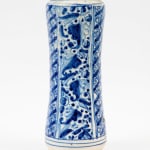Manga de Farmácia "Desenho Geométrico" , Lisboa, 1600-1625
faiança portuguesa
28 cm
C430
Further images
Exhibitions
Un Siécle em Blanc et Bleau, Galerie Mendes, Paris, 2016 (cat. pp. 44-45)Publications
ROQUE, Mário, Lisboa na Origem da Chinoiserie, Lisboa: São Roque, 2018 (pp. 56-57)
Elegante canudo de farmácia, de grandes dimensões, cilíndrico, com ligeiro estrangulamento central, base reentrante e bordo revirado, peça de faiança portuguesa do século XVII. A pasta está coberta com esmalte branco estanífero muito fino, com decoração a azul-cobalto de elevada qualidade.Corpo dividido em quatro largos painéis rectangulares verticais, preenchidos alternadamente por elementos vegetalistas e por um padrão geométrico. Termina junto à base com dois filetes.As reservas vegetalistas apresentam uma grande densidade de motivos florais onde se destacam elegantes folhas de acanto, muito ao gosto da majólica italiana. Estão separadas por rectângulos com treliça preenchida por espirais. As espirais, elemento decorativo muito utilizado para preencher espaços, no final do século XVI / princípio do seculo XVII, parece ter a sua origem na faiança de Granada e Valencia, embora surja também na faiança quinhentista de Iznik. Colo com uma cercadura de barras em azul e bordo branco revirado.
A gramática decorativa da peça está, pelo seu caracter e pelo horror vacui com que se preenchem as superfícies, mais ligada a modelos islâmicos e à estética dos centros de produção espanhola e italiana, que detinham grande popularidade na época, do que à produção chinesa.Segundo Maria Antónia Pinto Matos, este modelo hibrido conjugando as características europeias e as do Próximo e do Extremo Oriente é muito usual nas faianças do início de seiscentos, influencia das requintadas cerâmicas italianas de Montelupo, que se baseavam nas produções islâmicas peninsulares e do norte de África, mas trabalhadas já ao gosto europeu. Efectivamente a Espanha foi ocupada, entre o seculo VIII e XV, pelos Muçulmanos. Para além de Valencia e Málaga que produziam louça com reflexos metálicos, geralmente designada por hispano-mourisca, existiam algumas fábricas importantes nas Ilhas Baleares, que tinham um comércio muito intenso com a Itália, desde a ocupação cartaginesa.É provável que a palavra italiana maiólica ou majólica derive de Maiorca. Este nome aplicava-se apenas aos ricos artefactos com reflexos metálicos importados de Espanha e distribuídos para Itália através dos barcos de Maiorca e, só mais tarde, passou a designar o produto estanífero em geral.
A gramática decorativa da peça está, pelo seu caracter e pelo horror vacui com que se preenchem as superfícies, mais ligada a modelos islâmicos e à estética dos centros de produção espanhola e italiana, que detinham grande popularidade na época, do que à produção chinesa.Segundo Maria Antónia Pinto Matos, este modelo hibrido conjugando as características europeias e as do Próximo e do Extremo Oriente é muito usual nas faianças do início de seiscentos, influencia das requintadas cerâmicas italianas de Montelupo, que se baseavam nas produções islâmicas peninsulares e do norte de África, mas trabalhadas já ao gosto europeu. Efectivamente a Espanha foi ocupada, entre o seculo VIII e XV, pelos Muçulmanos. Para além de Valencia e Málaga que produziam louça com reflexos metálicos, geralmente designada por hispano-mourisca, existiam algumas fábricas importantes nas Ilhas Baleares, que tinham um comércio muito intenso com a Itália, desde a ocupação cartaginesa.É provável que a palavra italiana maiólica ou majólica derive de Maiorca. Este nome aplicava-se apenas aos ricos artefactos com reflexos metálicos importados de Espanha e distribuídos para Itália através dos barcos de Maiorca e, só mais tarde, passou a designar o produto estanífero em geral.
Join our mailing list
* denotes required fields
We will process the personal data you have supplied in accordance with our privacy policy (available on request). You can unsubscribe or change your preferences at any time by clicking the link in our emails.







